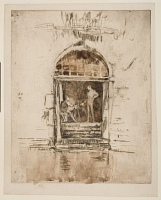Wool Carders | ||
| Number: | 195 | |
| Date: | 1879/1880 | |
| Medium: | drypoint | |
| Size: | 289 x 234 mm | |
| Signed: | no | |
| Inscribed: | no | |
| Set/Publication: | no | |
| No. of States: | 3 | |
| Known impressions: | 4 | |
| Catalogues: | K.221; M.218; W.191 | |
| Impressions taken from this plate (4) | ||
KEYWORD
canal, figure, man, textile, worker.
TITLE
Variations on the title are as follows:
'Wool Carders' (1883, FAS). 1
'Wool-Carders' (1886, Frederick Wedmore (1844-1921)). 2
'Wool Carders' (1887/1888, Whistler). 3
'Les cardeurs de laine. (The Wool Carriers [sic])' (1905, Paris). 4
'Wool Carders' is the original and generally accepted title.
'Wool Carders' (1883, FAS). 1
'Wool-Carders' (1886, Frederick Wedmore (1844-1921)). 2
'Wool Carders' (1887/1888, Whistler). 3
'Les cardeurs de laine. (The Wool Carriers [sic])' (1905, Paris). 4
'Wool Carders' is the original and generally accepted title.
1: London FAS 1883 (cat. no. 18).
2: Wedmore 1886 A (cat. no. 191).
3: List, [1887/1888], GUW #13233.
4: Paris Mem. 1905 (cat. no. 380).
DESCRIPTION
A view across a canal to a wide doorway, with an arched window above it, the panes divided by a rectangular iron grid. In the interior is a seated man working at a table, to left, facing another who stands at the right, his left hand on his hip, and his right hand holding something out towards the table. In front of them, stone steps lead down to the wide open doors, and two more steps to the canal. Above the arch is the bottom of a balcony, with cloths hanging over the railings. The stone wall each side of the door is barely indicated.
SITTER
Not identified. It is not actually possible to tell, except from the title, that the seated figure is carding wool.
SITE
Venice, Italy. Venice had been a centre of the wool trade in the Mediterranean for several centuries. It was also the centre for local wool production, from sheep raised in the Veneto and on the islands round the city. Spinning, wool working and related industries, such as dye-works, were based mainly around the Venetian lagoon. Thus this could have been situated near the site of The Dyer [192]. However, the precise site has not been identified.
